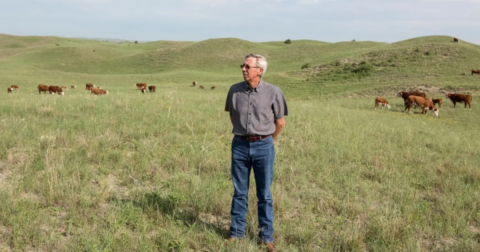Explainer
Agriculture Affects Deforestation Much More Than Most People Realize
Climate•7 min read
Solutions
The burgeoning cultivated meat industry has found some unlikely allies.


Words by Jessica Scott-Reid
Nebraska has officially signed into law a ban on the production, sale, promotion and distribution of cultivated meat — meat grown from animal cells rather than from animals raised on a farm for slaughter. But as Republican lawmakers in Texas, Montana, Indiana, Florida and other states pass similar legislation, lab-grown meat is finding unlikely allies among some ranchers and farming advocates. Their position? Let the free market decide whether it wants cultivated meat — not politicians.
While proponents have framed these bans as protection for traditional ranching and food safety, Dan Morgan, a fourth-generation Nebraska cattle rancher who produces Wagyu beef, rejects these arguments. He tells Sentient it should be up to consumers to decide what they want.
“The customer ultimately makes the decision whether they like your product or not,” says Morgan, rather than “more rules and regulations.”
Cultivated meat is produced by taking a small sample of animal cells and feeding them nutrients to grow in bioreactors that mimic the conditions inside an animal’s body. The result is meat that is biologically identical to conventional meat, and with the potential to be far more sustainable. The exact environmental impact, however, is somewhat uncertain.
David Kaplan, director of the Tufts University Center for Cellular Agriculture, previously told Sentient that researchers are currently unable to predict the exact amount of emissions mass production of cultivated meat would cause, because it’s still early days for these products, and a number of key variables, like availability of clean energy, remain uncertain. Kaplan does feel, however, that evaluations of sustainability overall suggest cultivated meat will be more sustainable to produce than conventionally farmed meat, especially beef, but it’s not yet clear “how much better,” he added.
Cultivated meat is available on a very limited scale. Four companies, Upside Foods, Good Meat (a division of Eat Just), Wildtype and Mission Barns have received full federal approval to sell it in limited markets. But in the U.S. so far, these products have been served at restaurants: Upside Foods’ cultivated chicken debuted at Bar Crenn in San Francisco, while Good Meat served its chicken at Chino Chicano, in Washington, D.C., though both restaurants have since paused offering it. Wildtype, a cultivated seafood company based in San Francisco, is the latest to receive FDA approval, and has begun selling its sushi-grade salmon at Kann, in Portland, Oregon. As of today, cultivated meat is not being sold in the U.S. at grocery stores.
Nebraska Governor Jim Pillen, founder of one of the largest hog operations in the U.S., championed the ban on cultivated meat in the state. In May, lawmakers approved Legislative Bill 246, introduced by Republican State Senator Barry DeKay at the request of Pillen. The Bill was signed in July, as Nebraska joins six other states that are effectively preemptively forbidding the product.
Both DeKay and Pillen cited reasoning for the ban rooted more in talking points than fact. Dekay believes cultivated meat producers are working to “socially engineer” consumers away from traditionally farmed meat products, while Pillen calls cultivated meat production “crazy far left ideology” that has no place in Nebraska.
These narratives echo false claims made about other alternative proteins, often framed as part of a left-wing agenda that threatens an American identity rooted in meat consumption. In reality, the way we eat accounts for one third of all greenhouse gas emissions — with most of those emissions driven by beef.
Dietary change is one of the most effective ways to curb those emissions, according to the climate research group Project Drawdown, with cultivated meat a potential climate solution in the mix. Lab-grown meat can appeal to meat eaters looking to cut back, but not quite won over by the taste of plant-based burgers.
Morgan is one cattle rancher who welcomes the competition and feels the conspiracy theories about social engineering are bogus. “That’s a typical right-wing conspiracy theory that they’re trying to instill into the mindset of people,” he says. “There’s not a factual word in there.” The way he sees it, both versions of meat products should be permitted on the market, leaving it to the consumer to decide. “The challenge for the meat industry is to make certain that we are producing a product that the customer wants and is willing to purchase,” he says.
Morgan may be an unlikely ally to the burgeoning cultivated meat industry, but he isn’t alone. He’s joined by groups like the Nebraska Farm Bureau and Nebraska Cattlemen, who also oppose the bans. “Consumer choice and individual freedom should always remain at the forefront of agriculture and food focused public policy,” Nebraska Farm Bureau wrote in a statement. They do, however, support food safety oversight and clear labeling — including not using the word “meat” on future cultivated meat packaging.
Barry Carpenter, a former USDA official and ex-CEO of the North American Meat Institute took a similar stance in an op-ed for the Houston Chronicle. Weighing in on the Texas ban, he wrote that “Texas ranchers aren’t afraid to compete,” arguing that bans are unnecessary government overreach that stifle consumer choice and go against free-market principles.
Cultivated meat that is served to the public is overseen by the USDA, the Food and Drug Administration and the Food Safety Inspection Service at different stages of production: harvesting, cultivating, processing, packaging and labelling.
Earlier this month, Sherry Vinton, director of the Nebraska Department of Agriculture, told the Nebraska Examiner that nutritional and safety standards for cultivated meat production aren’t on par with farmed meat products, and that while the cells are tested going into the process, the final products are not tested before they are sent out for sale.
Sentient reached out to the USDA about Vinton’s claim; it isn’t true. A spokesperson replied that both the Food Safety Inspection Service, as well as the Food and Drug Administration, “jointly oversee the production of cell-cultured meat and poultry products. FDA oversees preharvest production, which generally includes the collection, growth and differentiation of living cells into various cell types. FSIS oversees harvest and postharvest production, conducting inspections at least once per shift, just as any other processing establishment, to ensure that products are harvested, processed and labeled in accordance with applicable requirements before entering commerce.”
Despite the talking points from politicians looking to ban cultivated meat, Morgan says he does not believe cultivated meats are inherently unsafe. “Facilities need to be inspected,” he says, “just like our packing plants are inspected. Our cold storage facilities are inspected; our portion control facilities are all inspected,” he says. For Morgan, it’s the customer, not the government, that should be making the decision.